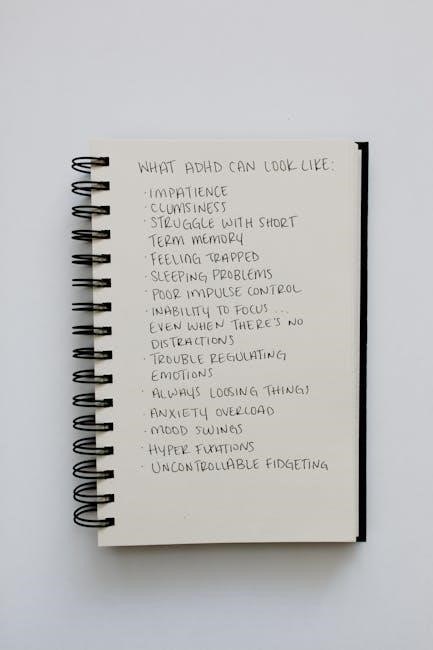Conjunctions are essential connectors in grammar‚ linking words‚ phrases‚ and clauses. They enhance sentence structure and clarity‚ categorized into coordinating‚ subordinating‚ and correlative types for effective communication.
What Are Conjunctions?
Conjunctions are words that connect other words‚ phrases‚ or clauses in a sentence‚ helping to establish relationships between ideas; They are essential for creating clear and coherent communication in both written and spoken language. Conjunctions can link ideas of equal importance or show a dependency between them. For example‚ words like and‚ but‚ or‚ and because are commonly used conjunctions. They can join simple sentences‚ creating compound or complex structures. Without conjunctions‚ sentences would lack variety and clarity‚ making communication less effective. Conjunctions are categorized into coordinating‚ subordinating‚ and correlative types‚ each serving distinct grammatical functions. Understanding conjunctions is vital for mastering English grammar and improving both writing and speech.
Importance of Conjunctions in Grammar
Conjunctions play a vital role in grammar by connecting words‚ phrases‚ and clauses‚ enabling the formation of complex and meaningful sentences. They provide clarity and coherence‚ showing relationships between ideas such as addition‚ contrast‚ cause‚ and time. Without conjunctions‚ communication would be fragmented and unclear. For example‚ they help link ideas logically‚ making sentences more expressive and precise; Conjunctions also facilitate the creation of compound and complex sentences‚ enhancing variety in writing and speech. Their proper use ensures grammatical correctness and improves overall communication effectiveness. Mastering conjunctions is essential for clear and impactful expression in both written and spoken English.

Types of Conjunctions
Conjunctions are categorized into coordinating‚ subordinating‚ and correlative types‚ each serving distinct roles in connecting words‚ phrases‚ and clauses to form clear and grammatically correct sentences.
Coordinating Conjunctions
Coordinating conjunctions are essential grammatical elements that connect words‚ phrases‚ or independent clauses of equal importance. They are represented by the acronym FANBOYS: for‚ and‚ nor‚ but‚ or‚ yet‚ and so. These conjunctions link similar grammatical structures‚ ensuring smooth transitions within sentences. For example‚ “I wanted to go to the park‚ but it started raining.” They can also combine clauses‚ creating compound sentences. Coordinating conjunctions are versatile and indispensable in constructing clear and meaningful sentences. Resources like PDF guides provide comprehensive lists and exercises to master their usage‚ making them a valuable tool for learning English grammar effectively.
Subordinating Conjunctions
Subordinating conjunctions introduce dependent clauses and connect them to independent clauses‚ showing relationships like time‚ cause‚ or condition. They cannot form a complete sentence alone. Examples include because‚ if‚ unless‚ and although. These conjunctions often appear at the beginning of a clause‚ such as “She left before the movie started.” They are crucial for expressing complex ideas and adding depth to sentences. Common subordinating conjunctions include after‚ although‚ as‚ as if‚ as long as‚ because‚ before‚ even if‚ even though‚ if‚ once‚ provided‚ since‚ so that‚ that‚ though‚ till‚ unless‚ until‚ and what. PDF guides often list these conjunctions with examples‚ helping learners understand their usage and grammatical roles.
Correlative Conjunctions
Correlative conjunctions are pairs of conjunctions that work together to connect words‚ phrases‚ or clauses of equal importance. They must be used in pairs to maintain grammatical correctness. Common examples include both.;.and‚ either…or‚ neither…nor‚ not only…but also‚ and whether…or. These conjunctions emphasize the relationship between the elements they connect‚ such as in the sentence‚ “I want either coffee or tea.” They are essential for showing equality or choice between ideas. PDF guides often provide comprehensive lists and exercises to practice using correlative conjunctions effectively in sentences‚ helping learners master their usage and improve clarity in writing and speech.

Coordinating Conjunctions
Coordinating conjunctions are essential connectors in grammar‚ linking words‚ phrases‚ and clauses. Common examples include for‚ and‚ nor‚ but‚ or‚ yet‚ and so. Use the acronym FANBOYS for easy recall. PDF guides and worksheets provide detailed lists and exercises for mastering their usage.
Conjunctions are words that connect or link elements in a sentence‚ such as words‚ phrases‚ or clauses. They help establish relationships between ideas‚ making communication clearer and more coherent. For example‚ coordinating conjunctions like and‚ but‚ or so join equal parts of a sentence. Subordinating conjunctions‚ such as because or although‚ introduce dependent clauses. Correlative conjunctions‚ like both…and or either…or‚ work in pairs to connect related elements. Examples of sentences using conjunctions include: “I like coffee‚ but she prefers tea” (using but) or “I will go to the park‚ or I will stay home” (using or). Conjunctions are vital for creating complex and meaningful sentences.
Common Coordinating Conjunctions (FANBOYS)
The acronym FANBOYS stands for the seven most common coordinating conjunctions: For‚ And‚ Nor‚ But‚ Or‚ Yet‚ and So. These conjunctions connect words‚ phrases‚ or independent clauses in a sentence. For example‚ “I wanted to go to the park‚ but it started raining” uses but to connect two contrasting ideas. Similarly‚ “Do you want coffee‚ or would you prefer tea?” uses or to present alternatives. FANBOYS helps remember these conjunctions‚ which are essential for creating clear and grammatically correct sentences. They link similar grammatical elements‚ ensuring smooth transitions between ideas in written and spoken language.
Using Coordinating Conjunctions in Sentences
Coordinating conjunctions are used to connect words‚ phrases‚ or independent clauses in a sentence. They help create compound sentences by linking equal grammatical elements. For example‚ “I wanted to go to the park‚ but it started raining” uses but to connect two contrasting ideas. Similarly‚ “Do you want coffee‚ or would you prefer tea?” uses or to present alternatives. For introduces a reason‚ as in “She stayed home‚ for she was not feeling well”. And connects similar ideas: “I love reading books‚ and my sister enjoys writing stories”. These conjunctions enhance sentence structure‚ ensuring clarity and smooth transitions in both writing and speech.

Subordinating Conjunctions
Subordinating conjunctions introduce dependent clauses‚ showing relationships like time or cause. Examples include because and after. They help establish clear connections within sentences‚ enhancing meaning and complexity.
Conjunctions are words that connect or join elements in a sentence‚ such as words‚ phrases‚ or clauses. They help establish relationships between ideas‚ making communication clearer and more coherent. For example‚ coordinating conjunctions like and‚ but‚ and or link equal parts of a sentence‚ while subordinating conjunctions like because or although introduce dependent clauses. Correlative conjunctions‚ such as both…and or either…or‚ work in pairs to connect balanced structures. Examples of sentences using conjunctions include: “She went to the store‚ and she bought milk‚” or “I wanted to leave‚ but I was too tired.” Conjunctions are essential for building complex sentences and expressing nuanced ideas effectively.
Common Subordinating Conjunctions
Subordinating conjunctions introduce dependent clauses‚ establishing relationships like time‚ cause‚ or condition. Common examples include because‚ although‚ if‚ unless‚ until‚ after‚ before‚ since‚ as‚ as if‚ as long as‚ even if‚ even though‚ so that‚ and that. These conjunctions help connect ideas‚ showing how clauses relate. For instance‚ I went to the park because the weather was nice uses because to show causation. Similarly‚ She studied hard so that she could pass the exam uses so that to indicate purpose. These conjunctions are vital for constructing complex sentences and expressing nuanced relationships between ideas.
Using Subordinating Conjunctions in Sentences
Subordinating conjunctions are used to connect a dependent clause to an independent clause‚ creating complex sentences. They introduce reasons‚ conditions‚ or time relationships. For example‚ because shows cause and effect: I stayed home because I was sick. Although contrasts ideas: Although it rained‚ we enjoyed the picnic. If expresses conditions: I will call you if I have time. After indicates sequence: After she finished work‚ she went to the gym. These conjunctions help clarify relationships between ideas‚ making sentences more informative and engaging. Proper use enhances sentence structure and adds depth to communication.

Correlative Conjunctions
Correlative conjunctions work in pairs to connect words‚ phrases‚ or clauses. Examples include both…and‚ either…or‚ and neither…nor‚ ensuring balanced sentence structure and clear relationships between ideas.
Definition and Examples
Conjunctions are words that connect words‚ phrases‚ or clauses in a sentence‚ enabling smooth communication. They are categorized into coordinating‚ subordinating‚ and correlative types. Coordinating conjunctions‚ such as and‚ but‚ and or‚ link equal parts of a sentence. For example‚ “I like coffee‚ but she prefers tea.” Subordinating conjunctions‚ like because or although‚ introduce dependent clauses‚ as in “He left early because it was raining.” Correlative conjunctions‚ such as both…and or either…or‚ work in pairs to connect elements. For instance‚ “I want both the book and the pen.” These examples illustrate how conjunctions enhance sentence structure and clarity in English grammar.
Common Correlative Conjunctions
Correlative conjunctions are pairs of words used to connect elements in a sentence. Common examples include both…and‚ either…or‚ neither…nor‚ not only…but also‚ and whether…or. These pairs work together to show a relationship between words or ideas. For instance‚ “both the students and the teacher attended the meeting” demonstrates the use of both…and. Similarly‚ “either you can stay home or you can go to the park” illustrates either…or. Correlative conjunctions ensure balance and clarity in sentences‚ making them essential for effective communication in English grammar. They are often used to present choices‚ contrasts‚ or inclusivity in a structured way.
Using Correlative Conjunctions in Sentences
Correlative conjunctions are used in pairs to connect words‚ phrases‚ or clauses of equal importance. They ensure grammatical balance and clarity. For example‚ “Both the manager and the team agreed on the plan” uses both…and to connect two subjects. Similarly‚ “Either we leave early or we will miss the train” employs either…or to present a choice. Another example is “Not only does she paint beautifully‚ but also she writes poetry‚” demonstrating not only…but also. Correct usage requires pairing the conjunctions properly and placing them before the elements they connect. This enhances sentence structure and ensures clear‚ effective communication in English writing and speech. Proper use of correlative conjunctions adds precision and sophistication to language.

Common Conjunctions List
A common conjunctions list includes and‚ but‚ or‚ so‚ for‚ nor‚ yet (coordinating)‚ because‚ after‚ although (subordinating)‚ and both…and‚ either…or (correlative).
Coordinating Conjunctions List
The most common coordinating conjunctions are: for‚ and‚ nor‚ but‚ or‚ yet‚ and so. These are often remembered using the acronym FANBOYS. They connect words‚ phrases‚ or independent clauses of equal rank in a sentence. Examples include:
- And
- But
- Or
- So
- For
- Nor
- Yet
These conjunctions are essential for creating compound sentences and ensuring smooth transitions between ideas. For example‚ “I wanted to go to the park‚ but it started raining‚” or “Do you want coffee or tea?”
Subordinating Conjunctions List
Subordinating conjunctions introduce dependent clauses and show the relationship between clauses. Common subordinating conjunctions include: after‚ although‚ as‚ as if‚ as long as‚ because‚ before‚ even if‚ even though‚ if‚ once‚ provided‚ since‚ so that‚ that‚ though‚ till‚ unless‚ until‚ and what. These conjunctions help establish time‚ cause‚ effect‚ or condition relationships. For example‚ “She left before the meeting started‚” or “I will go if you invite me.” They are essential for creating complex sentences and adding depth to communication. Using them correctly enhances clarity and sophistication in both writing and speech.
Correlative Conjunctions List
Correlative conjunctions work in pairs to connect words‚ phrases‚ or clauses of equal importance. Common examples include: both…and‚ either…or‚ neither…nor‚ not only…but also‚ and whether…or. These conjunctions create balance and emphasize equality between linked elements. For instance‚ “I love both reading and writing‚” or “You can choose either coffee or tea.” They are essential for showing contrast‚ inclusion‚ or alternatives. Using correlative conjunctions correctly ensures clarity and adds structure to sentences‚ making communication more precise and engaging. They are a fundamental part of effective writing and speech in English grammar.

Resources for Learning Conjunctions
Downloadable PDF guides and worksheets provide comprehensive lists and exercises for mastering conjunctions. Online tutorials and grammar websites offer detailed explanations and practice materials for all learners.
PDF Guides and Worksheets
PDF guides and worksheets are excellent resources for learning about conjunctions. Many educational websites offer downloadable PDFs that provide detailed explanations‚ lists of conjunctions‚ and practical exercises. These guides often include examples of how conjunctions are used in sentences‚ making it easier to understand their functions. Worksheets are particularly useful for practicing identification and usage of conjunctions‚ with exercises ranging from fill-in-the-blank activities to sentence construction. Some PDFs also include answers for self-assessment‚ helping learners track their progress. Additionally‚ resources like the 32-page paperback on basic English grammar are highly recommended for in-depth study. These materials are ideal for both students and educators seeking structured lessons on conjunctions.
Online Resources and Tutorials
Online resources and tutorials provide interactive and accessible ways to learn about conjunctions. Websites like Khan Academy and Grammarly offer detailed explanations and exercises to practice conjunction usage. Platforms such as Coursera and Udemy feature courses with video tutorials and quizzes to test understanding. Additionally‚ educational websites like poorvucenter.yale.edu provide downloadable guides and examples of conjunctions in sentences. These resources often include lists of conjunctions‚ such as coordinating‚ subordinating‚ and correlative types‚ along with their functions. Interactive tools and exercises help learners identify and use conjunctions correctly. Online forums and communities also offer support for clarifying doubts and discussing complex topics. These resources make learning conjunctions engaging and convenient for all skill levels.

Practical Applications
Conjunctions are crucial in enhancing clarity and flow in both writing and speech. They help connect ideas effectively‚ ensuring smooth communication in various contexts‚ from academic papers to everyday conversations.
Using Conjunctions in Writing
Conjunctions are vital for creating coherent and fluid sentences in writing. They connect ideas‚ phrases‚ and clauses‚ ensuring smooth transitions. Coordinating conjunctions like and‚ but‚ and or link equal parts of sentences‚ while subordinating conjunctions like because and although introduce dependent clauses; Correlative conjunctions‚ such as both…and or either…or‚ provide balance. Proper use enhances clarity and readability‚ making writing more engaging. For example‚ “I wanted to go‚ but I was busy” uses but to show contrast; Similarly‚ “She studied hard‚ and she passed the exam” uses and to connect related ideas. Mastering conjunctions improves communication‚ making writing more precise and impactful. They are essential tools for conveying complex ideas effectively in various writing contexts.
Conjunctions in Speech
Conjunctions play a crucial role in speech‚ enabling smooth communication by connecting thoughts‚ ideas‚ and clauses. They help speakers transition between words and phrases‚ making speech more natural and coherent. For instance‚ coordinating conjunctions like and‚ but‚ and or link ideas‚ while subordinating conjunctions like because and although introduce dependent clauses. Correlative conjunctions‚ such as both…and or either…or‚ add balance to expressions. Using conjunctions in speech clarifies relationships between ideas‚ reduces ambiguity‚ and enhances listener understanding. For example‚ “I wanted to go‚ but I was busy” uses but to show contrast. Effective use of conjunctions ensures speech flows logically‚ making communication more engaging and precise. They are indispensable for conveying complex ideas in a clear and structured manner.

Exercises and Quizzes

Enhance your understanding of conjunctions with practice worksheets‚ online quizzes‚ and interactive exercises. Identify conjunctions in sentences‚ complete fill-in-the-blank tasks‚ and create sentences using coordinating‚ subordinating‚ and correlative conjunctions. Resources like PDF guides and online platforms offer multiple-choice tests and grammar-focused drills to improve your skills.
Practice Worksheets
Practice worksheets are an excellent way to master conjunctions. They typically include exercises like identifying conjunctions in sentences‚ filling in the blanks with appropriate conjunctions‚ and creating sentences using specific types; Many worksheets focus on distinguishing between coordinating‚ subordinating‚ and correlative conjunctions. Some include matching games or word banks to reinforce learning. These resources often come in PDF formats‚ making them easy to print and use for self-study or classroom activities. Advanced worksheets may incorporate complex sentence structures or error analysis. Regular practice with these tools helps learners apply grammar rules effectively and improves both writing and speech clarity.
Online Tests
Online tests are a convenient way to assess understanding of conjunctions. They often include multiple-choice questions‚ fill-in-the-blank exercises‚ and sentence completion tasks. Many tests focus on identifying and using coordinating‚ subordinating‚ and correlative conjunctions correctly. Some platforms offer timed quizzes to simulate exam conditions‚ while others provide immediate feedback and explanations for incorrect answers. These tests are available on educational websites‚ language learning apps‚ and platforms offering PDF resources. They cater to all skill levels‚ from beginners to advanced learners. Regularly taking online tests helps improve grammar skills‚ boosts confidence‚ and enhances the ability to use conjunctions effectively in both writing and speech.
Conjunctions are vital for clear and effective communication‚ connecting ideas seamlessly. Understanding their types enhances grammar proficiency‚ ensuring precise and fluent expression in both writing and speech.
Recap of Key Points
Final Thoughts on the Importance of Conjunctions
Conjunctions are indispensable in grammar‚ enabling the smooth connection of words‚ phrases‚ and clauses. They prevent sentence fragmentation and enhance clarity‚ ensuring ideas flow logically. By mastering conjunctions‚ learners can express thoughts more coherently in both writing and speech. Coordinating conjunctions like and and but link equal parts‚ while subordinating conjunctions introduce dependent clauses. Correlative conjunctions‚ such as both…and‚ add balance. Understanding these connectors is crucial for effective communication‚ making them a cornerstone of English grammar. They are essential tools for clear‚ precise‚ and impactful expression in any context.
